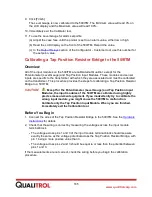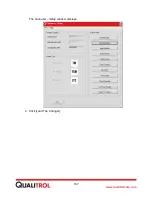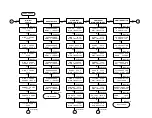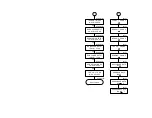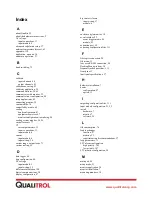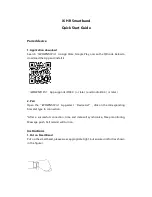
176
www.qualitrolcorp.com
Q:
What does it mean when the unit reads
“SENSOR ERROR” or “INVALID
READING”?
A:
If the 509ITM detects incorrect wiring, a broken wire, pinched insulation in the
connector, or missing sensor on the RTD input module, it will display
“SENSOR
ERROR
”. This alerts the user to investigate the RTD sensor and correct the
situation.
The “INVALID READING” will display for any “CT, Temperature” input modules that
use an RTD probe that has a sensor error. The winding temperature is calculated
from the current load and an oil temperature measurement. If the oil temperature
measurement has a sensor error, any calculation will be invalid.
Fixing the RTD issue will correct both the RTD sensor error and the invalid reading
for the winding temperature.
Q:
Are there any particular wiring methods for wiring a 509ITM?
A:
Wire the 509ITM according to your OEM/utility c
ompany’s practices and industry
standards. For those areas not covered, Qualitrol recommends the following:
•
Separate all power wiring (supply power, relay outputs, etc.) from analog wiring
(sensor inputs, current loop outputs, etc.) and digital wiring (RS-232, RS-485) in
different conduits, if possible.
•
Use shielded wire for all and twisted pairs for analog and digital wires. Shielding
and twisted pair will minimize noise radiating to and from the wire.
•
For all wiring, keep lengths as short as possible and use the heaviest gauge
wire that’s practical for the application. Wire has resistance and shorter lengths
and thicker wire minimizes that resistance.
•
Dress the wires so that none of the leads are pinched or strained, which might
shorten the life of the cabling.
Q:
What exactly is an RTD?
A:
RTD stands for Resistance Temperature Detector, and it is a device whose
resistance changes directly proportional to changes in temperature. For a 100 ohm
RTD, this is approximately 0.385 ohm per degree Celsius, and for a 10 ohm RTD,
this is approximately 0.0385 ohm per degree Celsius. See the following chart for
resistance values of the two types of RTDs at points of interest.
RTD Type
-40°C
0°C
25°C
120°C
10 ohm RTD
7.490 ohm
9.035 ohm
10.00 ohm
13.669 ohm
100 ohm RTD
84.27 ohm
100.0 ohm
109.73 ohm
146.06 ohm
Because of the small resistance values in an RTD sensor, Qualitrol recommends a
maximum of 75 feet of cable length. A typical application to measure the resistance
(temperature) changes in an RTD is for a monitor to send an excitation current
through the RTD and then measure the voltage across the device. This voltage is
then translated to the appropriate temperature value by the monitor.
Because an RTD is a resistive device, you must take the wire resistance into
account when doing any accurate measurement calculations. This can be
accomplished in different ways. One way is to send the excitation current through its
own pair of wires and measure the voltage across another pair of wires using only
Summary of Contents for 509ITM Series
Page 26: ...26 www qualitrolcorp com Current Input Wiring...
Page 55: ...55 www qualitrolcorp com 3 Continue with the setup procedure...
Page 101: ...101 www qualitrolcorp com...
Page 144: ...144 www qualitrolcorp com The following window will appear...
Page 167: ...167 www qualitrolcorp com The Customer Setup window displays 4 Click Load Tap Changer...
Page 178: ...178 www qualitrolcorp com Appendix...
Page 179: ......
Page 180: ......
Page 181: ......




